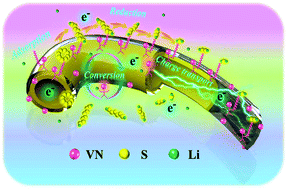Ammonia-free fabrication of ultrafine vanadium nitride nanoparticles as interfacial mediators for promoting electrochemical behaviors of lithium–sulfur batteries†
Abstract
Transition metal nitrides are promising mediators for improving the electrochemical performance of lithium–sulfur (Li–S) batteries, but the synthesis of ultrafine and durable nanoparticles in the absence of ammonia gas is still a great challenge. Herein, we reported a new method for the fabrication of ultrafine vanadium nitride (VN) nanoparticles uniformly embedded into N-doped porous carbon using a main-chain imidazolium-based ionic polymer (ImIP) containing metavanadate anions as a precursor. ImIP not only serves as sole carbon and nitrogen sources, but also effectively inhibits the aggregation and coalescence of VN nanoparticles during pyrolysis. Benefiting from the ultrafine particle size, high polarity and good electrocatalytic effects of VN, both redox kinetics of sulfur species and chemical adsorbability toward polysulfides are greatly expedited. The resultant electrode exhibits superior cycling stability with a low average capacity decay rate of 0.035% for 1200 cycles at a high rate of 5 C. This work develops a facile ammonia-free approach to fabricate ultrafine VN nanoparticles for improving electrochemical behaviors of Li–S batteries.

- This article is part of the themed collection: 2021 Nanoscale HOT Article Collection


 Please wait while we load your content...
Please wait while we load your content...